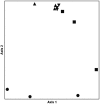Root-associated ectomycorrhizal fungi shared by various boreal forest seedlings naturally regenerating after a fire in interior alaska and correlation of different fungi with host growth responses
- PMID: 21441343
- PMCID: PMC3126461
- DOI: 10.1128/AEM.02575-10
Root-associated ectomycorrhizal fungi shared by various boreal forest seedlings naturally regenerating after a fire in interior alaska and correlation of different fungi with host growth responses
Abstract
The role of common mycorrhizal networks (CMNs) in postfire boreal forest successional trajectories is unknown. We investigated this issue by sampling a 50-m by 40-m area of naturally regenerating black spruce (Picea mariana), trembling aspen (Populus tremuloides), and paper birch (Betula papyrifera) seedlings at various distances from alder (Alnus viridis subsp. crispa), a nitrogen-fixing shrub, 5 years after wildfire in an Alaskan interior boreal forest. Shoot biomasses and stem diameters of 4-year-old seedlings were recorded, and the fungal community associated with ectomycorrhizal (ECM) root tips from each seedling was profiled using molecular techniques. We found distinct assemblages of fungi associated with alder compared with those associated with the other tree species, making the formation of CMNs between them unlikely. However, among the spruce, aspen, and birch seedlings, there were many shared fungi (including members of the Pezoloma ericae [Hymenoscyphus ericae] species aggregate, Thelephora terrestris, and Russula spp.), raising the possibility that these regenerating seedlings may form interspecies CMNs. Distance between samples did not influence how similar ECM root tip-associated fungal communities were, and of the fungal groups identified, only one of them was more likely to be shared between seedlings that were closer together, suggesting that the majority of fungi surveyed did not have a clumped distribution across the small scale of this study. The presence of some fungal ribotypes was associated with larger or smaller seedlings, suggesting that these fungi may play a role in the promotion or inhibition of seedling growth. The fungal ribotypes associated with larger seedlings were different between spruce, aspen, and birch, suggesting differential impacts of some host-fungus combinations. One may speculate that wildfire-induced shifts in a given soil fungal community could result in variation in the growth response of different plant species after fire and a shift in regenerating vegetation.
Figures



References
-
- Alberton O., Kuyper T. W., Summerbell R. C. 2010. Dark septate root endophytic fungi increase growth of Scots pine seedlings under elevated CO2 through enhanced nitrogen use efficiency. Plant Soil 328:459–470
-
- Bai S.-L., Li G.-L., Liu Y., Dumroese R. K., Lv R.-H. 2009. Ostryopsis davidiana seedlings inoculated with ectomycorrhizal fungi facilitate formation of mycorrhizae on Pinus tabulaeformis seedlings. Mycorrhiza 19:425–434 - PubMed
-
- Bent E., Taylor D. L. 2010. Direct amplification of DNA from fresh and preserved ectomycorrhizal root tips. J. Microbiol. Methods 80:206–208 - PubMed
-
- Booth M. 2004. Mycorrhizal networks mediate overstorey-understorey competition in a temperate forest. Ecol. Lett. 7:538–546
-
- Cairney J., Bastias B. 2007. Influences of fire on forest soil fungal communities. Can. J. Forest Res. 37:207–215
MeSH terms
Substances
Associated data
- Actions
- Actions
- Actions
- Actions
- Actions
- Actions
- Actions
- Actions
- Actions
- Actions
- Actions
- Actions
- Actions
- Actions
- Actions
- Actions
- Actions
- Actions
- Actions
- Actions
- Actions
- Actions
- Actions
- Actions
- Actions
- Actions
- Actions
- Actions
- Actions
- Actions
- Actions
- Actions
- Actions
- Actions
- Actions
- Actions
- Actions
- Actions
- Actions
- Actions
- Actions
- Actions
- Actions
- Actions
- Actions
- Actions
- Actions
- Actions
- Actions
- Actions
- Actions
- Actions
- Actions
- Actions
- Actions
- Actions
- Actions
- Actions
- Actions
- Actions
- Actions
- Actions
- Actions
- Actions
- Actions
- Actions
- Actions
- Actions
- Actions
- Actions
- Actions
- Actions
- Actions
- Actions
- Actions
- Actions
- Actions
- Actions
- Actions
- Actions
- Actions
- Actions
- Actions
- Actions
- Actions
- Actions
- Actions
- Actions
- Actions
- Actions
- Actions
- Actions
- Actions
- Actions
- Actions
- Actions
- Actions
- Actions
- Actions
- Actions
- Actions
- Actions
- Actions
- Actions
- Actions
- Actions
- Actions
- Actions
- Actions
- Actions
- Actions
- Actions
- Actions
- Actions
- Actions
- Actions
- Actions
- Actions
- Actions
- Actions
- Actions
- Actions
- Actions
- Actions
- Actions
- Actions
- Actions
- Actions
LinkOut - more resources
Full Text Sources
Medical
Molecular Biology Databases
Miscellaneous

